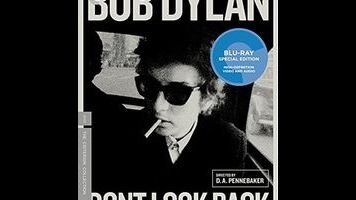Not that we’re necessarily seeing the “real” Bob Dylan, mind. Pennebaker’s direct-cinema approach—no narration, no direct interviews, no context—makes Dont Look Back feel raw and unvarnished, as does the grainy black-and-white 16mm stock. But Dylan is clearly aware of the camera at all times, and while there are a few scenes when he seems too relaxed to be consciously acting, one can never be too sure. One of the funniest offhand moments occurs early on, when Dylan reads aloud a story that’s been written about him in one of the London papers, which claims that he smokes 80 cigarettes per day. “I’m glad I’m not me,” he says, amused, and while that line is barely even audible, it still functions as a theme of sorts. The ’65 Newport Festival, at which Dylan was notoriously booed when he “went electric,” was just a few months in the future, and already he’s clearly concerned with how he’s being defined. The subject comes up again and again, with Pennebaker even throwing in (again, without context) a quick “flashback” (shot by Ed Emshwiller) to Dylan’s original look and sound, showing him performing “Only A Pawn In Their Game” two years earlier, when he was still basically a immensely gifted Woody Guthrie clone.
Dont Look Back captures Dylan at his most charismatic, and arguably at his most arrogant. (This is the version of him played by Cate Blanchett in Todd Haynes’ kaleidoscopic portrait I’m Not There.) Its most famous scene, apart from the opening music video, shows him ostensibly being interviewed by Horace Freeland Judson, a London correspondent for Time. Judson can barely get a word in as Dylan heaps abuse on the magazine and on mainstream journalism in general, and while our hero makes a few worthwhile points—notably regarding how much Time and its ilk have to lose by printing the unvarnished truth—he also oozes smug condescension. “I know more about what you do—and you don’t even have to ask me how, or why, or anything—just by looking, than you’ll ever know about me. Ever,” he tells Judson. “I mean, I could tell you I’m not a folk singer, and explain to you why, but you wouldn’t really understand. All you could do, you could nod your head.” When Judson politely asks him to try explaining, he refuses. “Do you ask The Beatles that?” Dylan demands of one question, echoing Billy Bob Thornton’s “Would you ask Tom Petty that?” decades before the fact. It’s kind of insufferable, frankly—but also mesmerizing.
Plus, Dylan probably isn’t taking any of this very seriously. At the end of the Judson interview, he insists that he’s every bit as great a singer as Enrico Caruso, and can’t suppress a smile as he makes his case. An earlier encounter with some teenage girls (who’d probably been screaming at The Beatles a couple of years earlier) similarly shows him in a puckish state of mind. One of them complains that his new electric material doesn’t sound like him; rather than argue or take offense, Dylan explains that he’s just trying to give some work to his friends—and they can’t possibly object to that, can they? Throughout the film, he’s seen laughing, joking, clowning around. His romance with Joan Baez was more or less over by this point, but they nonetheless seem perfectly at ease around each other. Pennebaker surely shaped the material he captured over these few weeks, but his primary virtue is simply to have chosen a great subject and then stayed out of the way. There are a number of notable Dylan documentaries—even Martin Scorsese has directed one, 2005’s No Direction Home—but anyone seeking a cinematic primer should start here. Dont think twice.









































